Water is second only to air when it comes to survival. Without water, you cannot survive for more than three days.
In other words, in any survival situation, whether the collapse of society has finally arrived or you are stranded in the bush for an unknown amount of time, having a way to purify water can literally mean the difference between life and death.
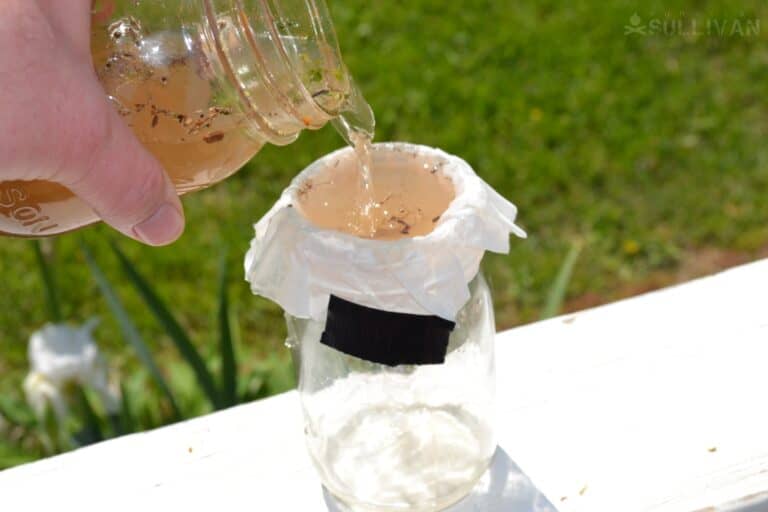
There are a number of effective ways to purify water while on the go. If you find water and don’t take the time and effort to purify it, you might end up making yourself really sick, which won’t help your survival situation.
Knowing the safest ways to purify water, and having at least two or three of these methods at your disposal wherever you are will ensure you are well hydrated and can focus on other aspects of survival, such as getting food and finding or making shelter.
Table of Contents
The Need for Water Purification
Water is not as clean as it looks, despite the fact that we use it to clean ourselves and our clothes and dishes. Even when you see a beautiful river or stream flowing that looks crystal clear, there are still things in that water that could make you sick.
Many bacteria, viruses, and protozoa (a single-celled organism), as well as other types of impurities thrive in the lakes, rivers, and streams from which we take our drinking water.
The water that gets piped into our homes is purified before it flows through the pipes to us, but if you get it right out of the river or lake, then you need to purify it yourself.
When I say that these things can make you sick, you might be wondering how sick. Well, to put simply, you could get a bad case of diarrhea or you could become infected with something so nasty that you will die.
Yes, death can be an outcome to drinking unpurified water, so you should NOT take any chances. Some symptoms of drinking unpurified water include abdominal pain, diarrhea, vomiting, fever, fatigue, and weight loss. There are many potential consequences to drinking unpurified water, including catching:
- Infectious diseases
- Diarrhea from pathogens such as E. Coli
- Hepatitis A
- Cholera (comes from drinking water in which there are feces); this is very deadly
- Amoebiasis (caused by a protozoa that lives in water or sewage containing flies)
You can also ingest the following from unpurified water:
- Chemicals from farm runoff, household waste, and industrial waste
- Pesticides
- Lead
- Heavy metals, such as arsenic
Methods of Water Purification
There are many ways to purify water. Some of these you can prepare for ahead of time, such as when you are at your bug-in or bug-out locations or you have packed the necessary equipment/chemicals to carry with you when you are in the bush.
There are also times when you might find yourself without convenient methods of water purification and have to wing it. The following are the best methods of water purification whether you have planned ahead of time or you need to purify water on the go, without prior planning.
With a Personal Water Filter
Simply filtering water through a cloth, even a finely woven one, will not purify your water; it will remove larger particles and make the water look more visually appealing. It certainly doesn’t hurt to filter your water before you purify it.
Check out this article on how to build a DIY water filter. But if you apply microfiltration or ultrafiltration, to the water, you can remove harmful bacteria and other impurities that could make you sick.
Microfiltration has an average pore size of 0.1 micron and will effectively remove protozoa from the water. However, it is only moderately effective at removing bacteria and it will not remove viruses or chemicals.
Ultrafiltration has an average pore size of 0.01 micron. It is very effective in the removal of protozoa and bacteria, is moderately effective in the removal of viruses, and has a low level of effectiveness of removing chemicals.
There are many commercial water filters on the market that will provide microfiltration of water. They come in all shapes and sizes. Some are simple filter straws, such as the LifeStraw, which are easy to carry and can be used anywhere.
Some, such as Sawyer’s Personal Water Bottle and Vestergaard’s LifeStraw Go, are water bottles that have a built in filter. Others, such as the MSR MiniWorks , use a ceramic filter and will attach to the top of a standard Nalgene water bottle or MSR Dromedary bag.
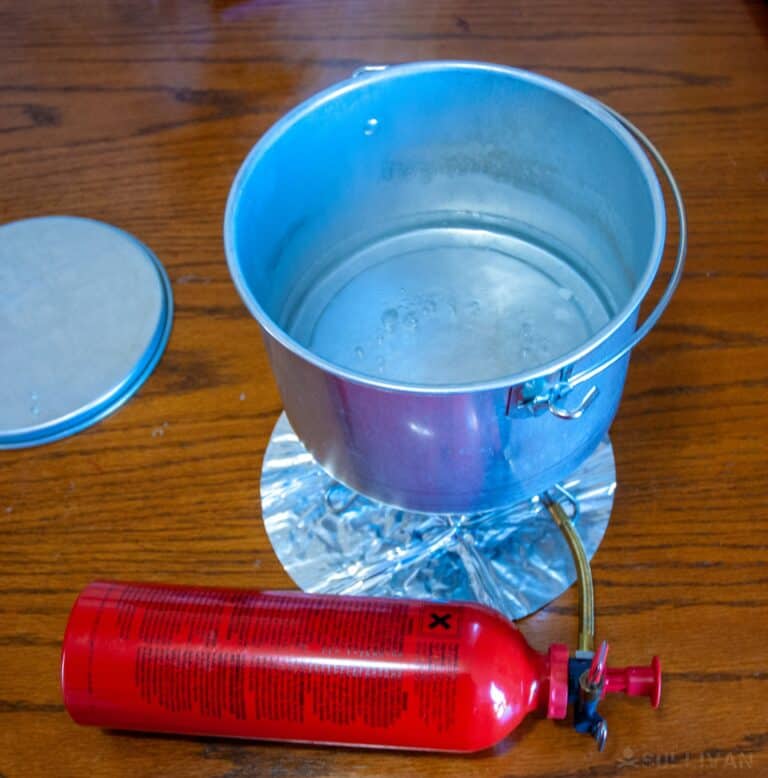
Boiling It
The simplest and cheapest method to purify water is to boil it. As long as you can start a fire or have a stove or some means of heating water to the boiling point and you have a pot or other metal container in which to put the water, you can purify it.
Once the water reaches 100 degrees Celsius and remains at a rapid or rolling boil for at least 1 minute (3 minutes at altitudes of more than 5,000 feet/1,000 meters), it will kill off all the harmful bacteria, viruses, and protozoa in the water.
Once the water has cooled down, it can be used for drinking. One of the major downfalls of this method is that it will not rid the water of any chemicals or metals.
This means that boiling water after it has been filtered is a great way to institute a sort of one two punch when it comes to making your water safer.
Alternately if the water you have sourced is clear enough you might boil it and then filter it, but make sure you allow the water to cool substantially before running it through your filter so you don’t damage any important components!
With a DIY Water Filter
Although you probably don’t want to end up using this method, it IS possible to get reasonably clean water with a DIY water filter. You will need a few things:
- gravel
- sand
- coffee filter
- plastic water bottle (it will act as a container)
- and activated charcoal
We have full instructions on how to build one here.
It is worth keeping in mind that even the simplest, improvised water filtration methods can have value, generally if they are used as a precursor to more advanced filtration or other methods of purification.
Contamination in the form of large solids or debris, even mineral contamination, can be removed using something as a simple multi-stage filter or something as primitive as a bandana, cheesecloth or other fabric.
Also take notice that multiple rounds of simple filtration through successively finer types of fabric can dramatically improve the taste and appearance of water, even if it won’t catch many microorganisms.
Running your water through a towel, then a bandana, then a cheesecloth and finally through a coffee filter is somewhat laborious and will definitely take time, but the result will be dramatically improved compared to a simple, hasty stage.
Every prepper should become well acquainted with fashioning and utilizing DIY filtration since it is one of the most viable methods for long-term sustainment when in an austere environment or when other supplies are scarce.
Chemical Treatments
Chemicals can be used to purify water and this is perhaps the second easiest way to accomplish this goal. There are many chemicals that can be used to purify water. Perhaps the most readily available in a bug-in situation are bleach and iodine.
There are also chemicals that come in the form of crystals, tablets, or liquids that are designed for people to carry with them when hiking or camping.
Some old school but still indisputably effective chemical sterilization tablets, crystals or liquids that are commonly used by explorers, adventurers, the military and other outdoor centric personalities and professions include chlorine, sodium dichloroisocyanurate and trochlosine sodium.
All are generally reliable under a broad spectrum of applications and it is the rare outdoor survival kit that is complete without them. Like other methods of purification, they do nothing to remove or otherwise neutralize other harmful chemicals and contaminants like heavy metals, so keep that in mind.
Also pay close attention to the usage instructions because all very somewhat and how much is needed to a certain quantity of water, the time needed for proper purification and other factors.
Be sure to follow whatever manufacturer’s instructions are included exactly because many of these chemicals can be harmful themselves in high concentrations!
There are also chemicals that come in the form of crystals, tablets, or liquids that are designed for people to carry with them when hiking or camping. Here is a list of chemicals and how to use them:
Bleach
Bleach is extremely effective, affordable and widely available so there is no reason why you shouldn’t make use of this prepping powerhouse for water purification.
Just keep in mind that its effectiveness is reduced in turbid or cloudy water, so do everything you can to pre-filter the water before relying on bleach for the finishing, knockout punch.
Make sure the bleach is pure, with no additional cleaners or scents added. You also want to ensure it is not color-safe.
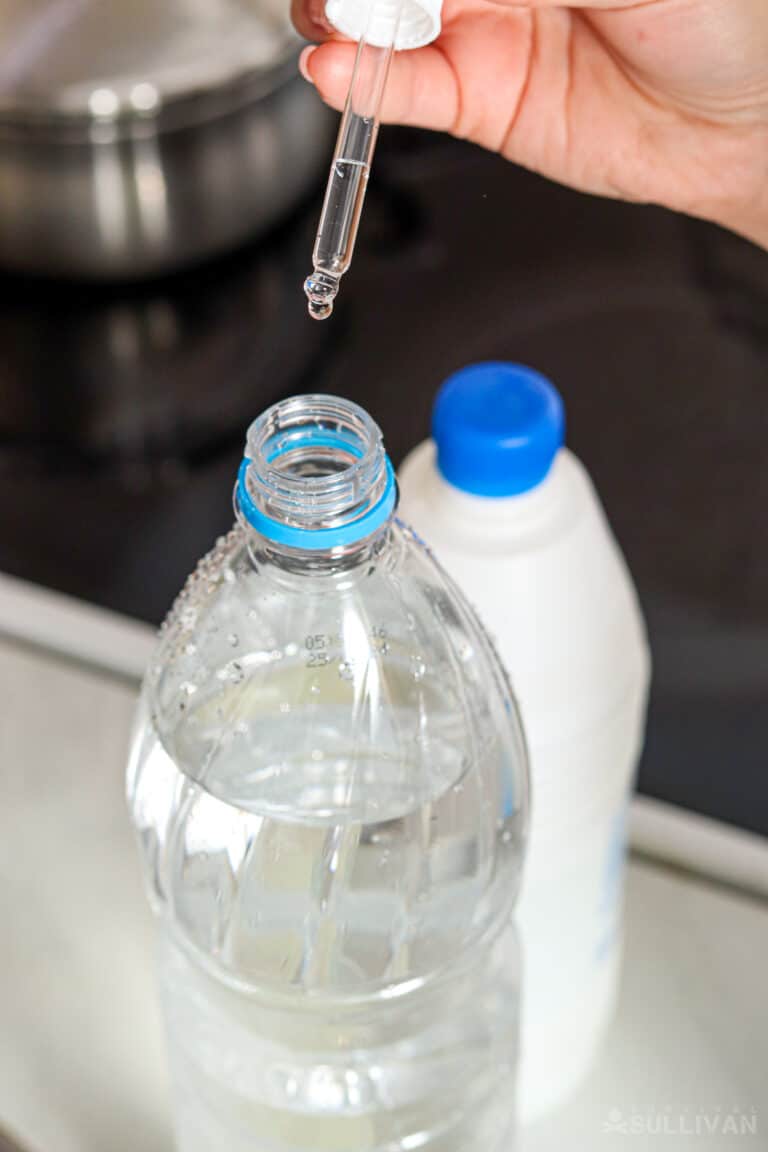
Add 1/8 teaspoon of bleach to one gallon of water, shake it, and let it sit for at least 30 minutes. DO NOT add more bleach than this as it can be harmful to humans at higher concentrations.
Iodine
Iodine is a famous, or perhaps infamous method of sterilizing water, and though it is effective, thorough and extremely portable it is somewhat reviled for making water taste nasty.
Once again, iodine is only effective against microorganisms, not any sort of other chemical contamination or dissolved solids. Use 2% tincture of iodine and add 5 drops per liter of water and 10 drops per liter if the water is cloudy. Let it sit for at least 30 minutes.
DO NOT use more than this as too much iodine can be harmful to humans, particularly to children and pregnant or nursing women.
Hydrogen Peroxide
Use 3%-10% diluted hydrogen peroxide. Because it is a weaker microbiocide, you will need more of it. Use 1/8 cup to one gallon of water.
Keep in mind that this is not a method of water purification that is approved by the U.S. Environmental Protection Agency, but it is useful to know in a pinch.
Tablets and Crystals
There are different types of water purification tablets and crystals, all of which are designed to simply be dropped into the water. Iodine and potassium permanganate can come in tablet- or crystal-form. Sodium chlorite (a form of chlorine) comes in tablet-form.
Purification tablets such as these are stockpiled by most preppers. They are cheap, small and lightweight, so I recommend you keep them in all of your survival bags.
When it comes to using prepackaged chemical water treatments, always follow the manufacturer’s directions on the product packaging. These directions will vary depending on the type of chemical being used.
Distillation
Distillation is a method of allowing water to evaporate and then re-condense on a surface from which it can be transferred into a container.
Distillation can be a slow process, but is effective, particularly if you use a solar still. Distillation, though slow and comparatively complicated compared to other methods on this list, will produce quite literally the purest cleanest water available anywhere in the realm of practicality.
This is because when water turns into steam it leaves behind all contaminants, including heavy metals, chemicals, dissolved solids and more. Upon condensing back into liquid, assuming it is captured in a suitably clean vessel, it will be entirely pure and safe to drink.
This makes distillation the go-to option for making the most suspect or contaminated water safe to drink in a pinch, or ensuring that especially high quality, clean water is obtained for special purposes.
As mentioned above, this method is applicable to bug in survival situations as well as bugging out, as field expedient methods can work quite well as we will learn in the next section.
If you have a stove and a couple of pots of different sizes, you can distill your water at home. Here’s a quick video showing you how to make this at home:
Solar Methods
A variation of the method above if you’re outdoors is to rely on the power of the sun. A solar still is a field expedient method of distilling water, and can even be used in terrain where no water is close at hand my capitalizing on the moisture present in the soil already.
If you are in the bush or field and you need to purify water, use a clear or translucent sheet of plastic and secure it over a hole that is 3 feet deep. Place a rock in the center on top of the plastic and a container in the center of the bottom of the hole and allow the sun to work its magic.
As the water evaporates, it will condense on the underside of the plastic and will run down and drip into the container. You can put water from a river or lake into the hole to distill it.
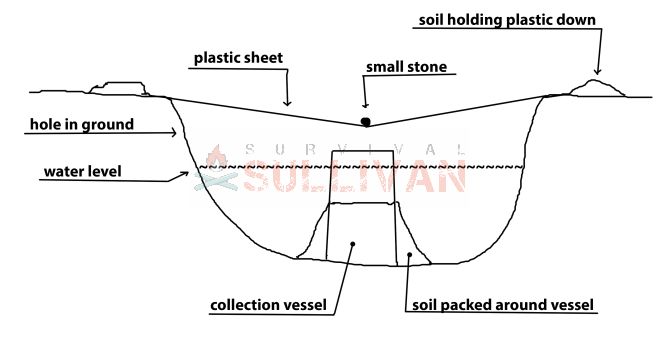
As might be expected, utilizing a solar still requires practice, experimentation and refinement, and the water yielded over time is quite small but significant if you are able to set up multiple stills or are in an environment where water is scarce in any case.
If you are attempting to distill water from the moisture in the ground itself, you can add vegetation or even urine to the hole to increase the level of moisture that can be distilled. A great demonstration can be seen in the next video: video:
We talked in-depth about making a solar water distiller outdoors here.
Another purification method which involves the sun is to use a water bottle.
This is one of my favorite water purification methods and is highly adaptable to all kinds of survival situations. All you’ll need to pull it off is a transparent container, either glass or plastic but plastic is generally best, and a clear view of open sky during the daytime. If the sun is out, you are halfway home with this method!
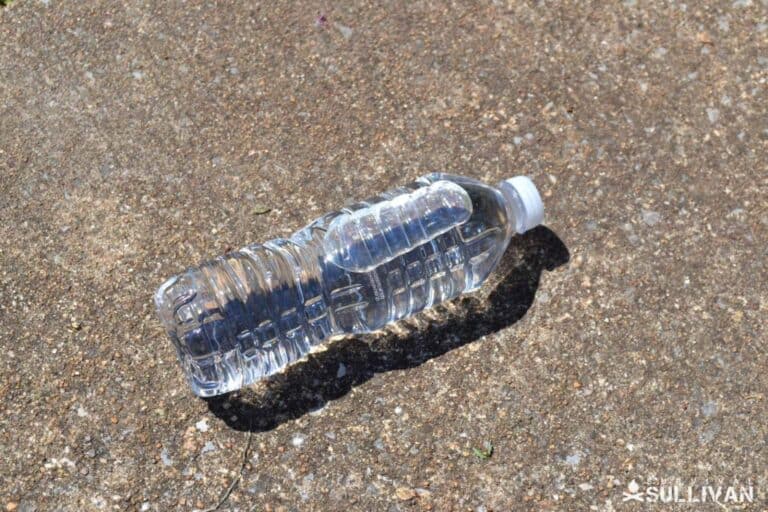
This method works to disinfect water because prolonged UV radiation bombardment destroys the vast majority of microorganisms.
Happily, the sun is a practically limitless source of this radiation that we can put the good use for the purpose.
Simply fill up your container with water, tightly cap it and then leave it in a direct sunlight, preferably on a light colored background. If you have full, strong sunlight, a half-day worth of exposure will do it. If you have week or intermittent sunlight, give it a full day to be on the safe side.
Note that this is another technique that is impaired by cloudy, murky water so do the best you can to pre-filter it for best effect. Once again, it does not do anything to eliminate chemical or heavy metal contamination. Microorganisms only!
Cilantro Purification
Out of all the methods of water purification featured on this list, this is the one that must be some sort of alchemy, if not outright magic.
Believe it or not, cilantro, and I mean, garden variety cilantro you can grow yourself or buy at the grocery store, can be used to purify water. Most impressively, and unbelievably true, it even removes heavy metals from the water where other methods, including some filters, fail.
How is it possible? I will spare you the scientific lecture, but suffice it to say that this method has been tested both large and small scale by science departments in major universities and it is dependable.
All you need to do is place fresh cilantro in a container holding your water, be it a bottle, jug or anything else and then walk away. That’s it. It takes time for the cilantro to purify the water, but it invariably does so, attracting and binding heavy metals to it but absolutely no other effort required.
Give the process about 24 hours, perhaps a little longer, and then remove the cilantro. Boom! That’s it! This is one of the only, if not the only, adaptable field expedient method for producing purified water free of heavy metals and this makes it an invaluable addition to the survival toolbox of a rural and urban preppers alike.
Desalination
Desalination is a process that is rarely discussed in a survival context because it is either so difficult to achieve in an improvised method or is accomplished by way of another purification procedure mentioned elsewhere on this list.
Desalination is the process of removing salt from salt water, leaving freshwater behind that is safe, or safer, to drink. As you already know, you cannot drink salt water, not at all, as it will make you gravely sick and eventually kill you.
Desalination is typically performed on an industrial scale for seaside communities that lack many other freshwater resources.
In bygone years, this procedure was pretty much restricted to installations, structures, for the purpose but nowadays quite a few companies make effective, portable desalinators for household use or use aboard boats and ships.
They can be expensive, but for preppers spending a lot of time near the ocean these might be a worthwhile addition to your arsenal.
If this is untenable or unachievable, you may safely and reliably desalinate water via distillation described above.
U.V. Purification
Dedicated UV purification works, as we learned in the solar disinfection method above. But when the sun is unavailable, impractical or just too doggone slow we can turn to a technological solution to accomplish the same thing.
Ultraviolet sterilization pens or probes do the same thing the sun can do only much faster since they crank out considerably more intense UV radiation after being inserted directly into a captured water source.
This ultraviolet radiation will destroy microorganism contaminants, including bacteria, viruses and many parasites.
Since none of these hostile little critters can even withstand the sun for long periods of time getting a full blast of high intensity UV radiation at literally point blank range is more than enough to obliterate them reliably and quickly.
To use one of these UV purification wands all you need to do is turn it on, insert it into your water and then swish or stir the water around gently. Note that just like the solar disinfection method above this only works well and reliably on water that is highly transparent.
If the water is murky or cloudy you would be well served to filter it first before switching to UV. Once again, this method only eliminates microorganisms, not dissolved solids or chemical contamination!
Wrap-Up
As you can see, there are a few good options to making sure you have drinkable water during and after an emergency.
If you can pre-filter it using a coffee filter or a bandana, the two best ways I recommend you rely on are personal water filters, and water purification tablets. They are not only the easiest, but unlike the DIY water filter, they will always give you 100% clean water.
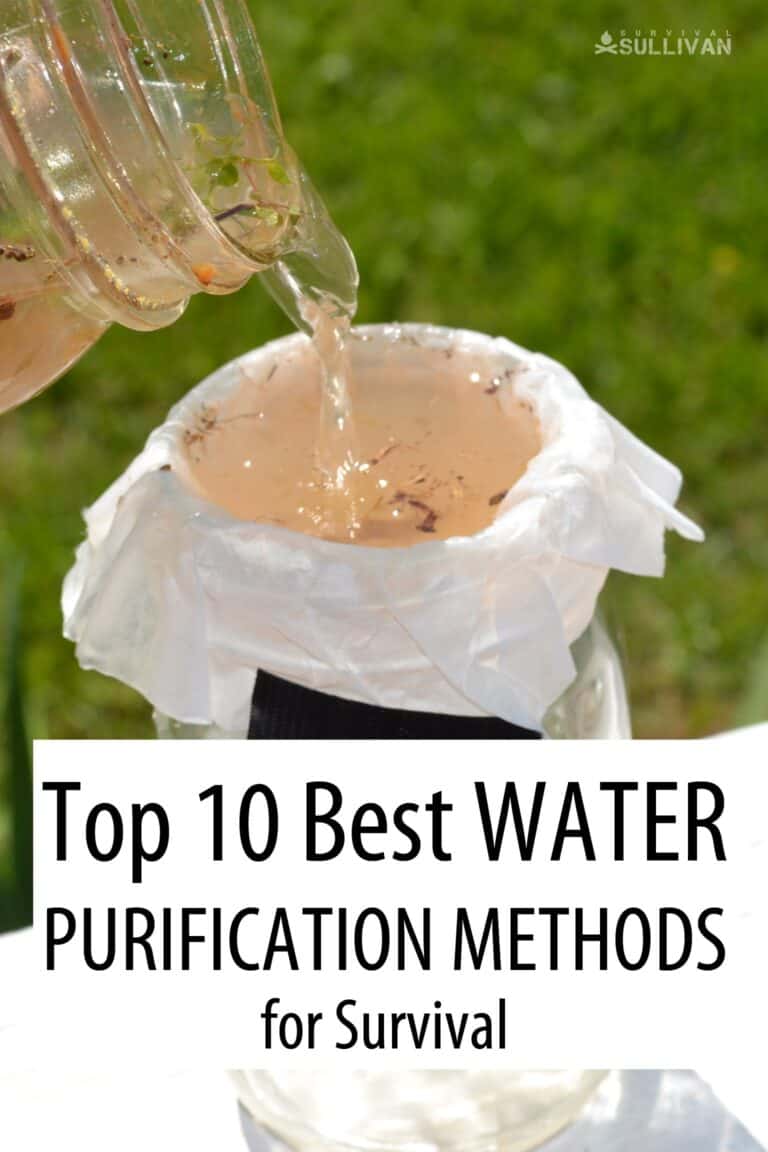
latest update 12/10/2021

An urban prepper and rural wannabe, Karen has been working as a freelance writer for a decade and prepping for about half that time. She has gathered a wealth of knowledge on preparing for SHTF, but there is always more to learn and she has a passion for gathering and sharing that knowledge with other like-minded folk. Karen lives in London, Canada with her two children and plethora of cats.

Need more on water.
A few of my thoughts on water filtration, purification, and treatment:
First, some of the definitions by which I go by when discussing water and its safe consumption. Filtration is a fairly limited term. Water filters can ‘filter’ out quite a few types of things in water that are harmful to humans. That includes some biologicals, such as many bacteria, and some protozoa. Depending on the actual filter components, and how the filter is used, some can remove several other things, from tastes and odors to heavy metals. But it is situational specific to both the filter and the concentration of the things in the water. And it can, and often does, depend on the time that the water takes to pass through the filter. Fast is not always best. Some things require more time in contact with the filtration materials to be removed than others. As always, check the manufacturer’s recommendations. One thing that filtration does not remove, by legal definition, is viruses.
A purifier, by legal definition, is a water treatment process that does remove viruses. That does not mean it will remove anything else in particular. They will usually remove most of the other biologicals, simply due to the fact that the process required to remove viruses is almost always just as effective removing bacteria and many other protozoa. Purification does not, in the legal definition applied to field water treatment, have to remove anything else but those specific biologicals. Tastes, odors, metals, chemicals of several types, and so on, will not be removed UNLESS the particular device so states that it incorporates the elements to take them out in addition to taking out the viruses.
A case in point in one of the Sawyer purifiers that uses the same technology used in dialysis machines. The tubes in the system have passages that are simply too small for almost all viruses to pass through. However, these tubes do not remove things like tastes and odors, heavy metals, and many other things that are not particulates. So, for a complete system to not only ‘purify’ the water to remove viruses, but remove many of the other objectionable or potentially dangerous contents, additional treatment techniques must be used.
Which brings me to the term treatment. In its basic form, it can mean pretty much anything done to water to change it from one state to another. The way I see it, when referring to turning water that might not be safely potable to water that is, treatment means doing something to the water that interacts with the water in some chemical way, as opposed to a mechanical way, such as particulate filtration. Purification tablets that use a chemical to kill viruses and bacteria, as opposed to removing them, is a type of treatment.
The dead biologicals are still in the water, UNLESS another stage does filter them out. In a similar vein, using activated charcoal to remove tastes, odors, and some of the other nasty things that can be in water, is more than just a mechanical removal of particulates. The things that either cause the effect, such as odor and taste, or are the actual chemical formulation that does the damage, are chemically bound to the activated charcoal, not physically stopped by mechanical action. This is not to say that activated charcoal does not have some mechanical filtration action. It does. But its primary use is for chemical capture.
Now, on to some other factors. Where the micro porous tubes are usually quite uniform in size, many of the ceramic filtration units are not. Micro porous tubes are often stated in the size of the particulates that will not pass through them in micron as an absolute number. Nothing that size or larger will pass. In most of the ceramics filters, there will be some variation in pore size. The rating is usually stated, or understood, to be a relative number. While some things larger than the stated rating size might get through, there will be few enough of them to consider the filter to be able to ‘effectively’ remove particles down to the stated size. It is a matter of percentages. And how dangerous a certain percentage of a biological is to the human body. For this reason, I almost always use a purifier, or a system that kills viruses if it does not remove them.
I do not want to mislead anyone. The filter systems produced by reputable companies are effective. They just are not an absolute, the way many other things are not absolutes.
Just be aware that there are more things involved in creating potable water than bacteria and viruses.
When it comes to the chemical killing of viruses, and some of the other little beasties, takes more time than it does for the majority of bacteria. Where a few minutes will kill many bacteria, it could take 40 minutes to well over an hour of allowing the chemical to do its work to kill some viruses and other biologicals, especially when the water is cool or cold. Again. Read and follow manufacturers instructions.
Some things about the collection of water. If pulling water from a natural source, especially if it is not flowing, and crystal clear, try not to pull directly from the surface of the water, or from the bottom of the source. Both can contain things that are hazardous, and often are very ‘dirty’ with particulate matter, which will quickly clog pretty much any and all water collection systems. I have found it most productive to pull water from about an inch below the surface of the water, if at all possible. And this using some type of screen and/or pre-filter. The more spread out the intake is, the better. A quarter inch opening hose poked into the water is not nearly as effective as a pancake type screen that can pull water from a wide area, with each little bit travelling very slowly in comparison to what is flowing through the hose in total.
Another method if the water is murky or has particulates is to dip or pump it into a container and let it settle for a time, and then pull the clearest water from above the sediment.
One of the factors between the choice of a pump type water treatment system and a drip-through system is the time required at the source of the water. If things are such that being exposed at a water source is dangerous, it is much better to have a container that can be filled quickly with raw water, the water transported to a safe place, and then run it through a drip unit. Or even a pump unit.
Water is heavy. If you are going to need to transport much of it any distance, make sure you have a method that will not wind up causing you injury, but will also be fairly quick. Include hoisting methods if you need to get it up to a second or higher story in a building, or just up a slope.
There are lots more factors that can be discussed.
All of the above is just my opinion.